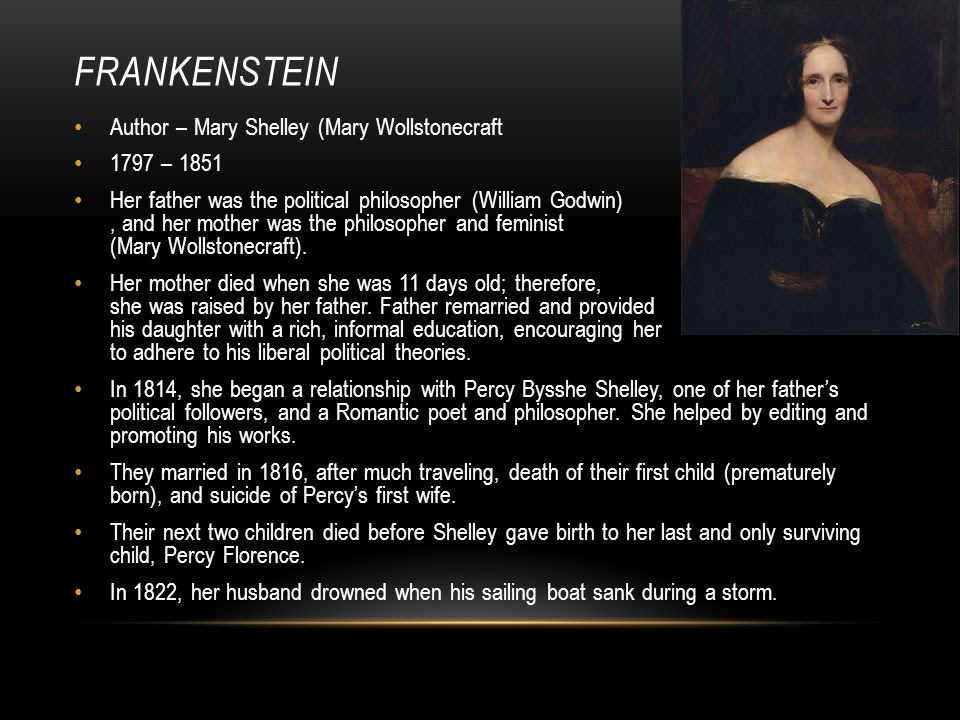 |
| https://www.slideshare.net/ArtsTeacher/00-visual-artsassessmentcriteria-38959745 |
Criterion A – Knowing and understanding
i. demonstrate knowledge of the art form studied, including concepts, processes, and the use of appropriate language
ii. demonstrate knowledge of the role of the art form in original or displaced contexts
Task: Write an essay that answers the following question:
Why is Mary Shelley's Frankenstein still relevant today? Use subject specific terminology in your essay.
Paragraph 1 - Introduction; background on Mary Shelley
Paragraph 2 - Art Form; Role of Art Form (What genre is this film? What are the elements of this genre?) (When did this art form begin? What was going on in society when this art form began?)
Paragraph 3, 4, 5 - Discuss Themes (minimum of 3) (Say why they were important when the book was written. Say why they are still relevant today.) (Explain, include details, include examples).
Paragraph 6 - Explain how all of this research will help you produce and perform in a 3-act play.
October 1, 4, 7
1. Poll Results - 11 people voted to continue with warm-ups
October 1 Warm-up: The Mirror Activity, purpose: Observation
In order to play different characters and act out different situations we need to be aware of what’s around us, and notice the details; Observation.
• Pair the students up and have them assign one person an “A” and another a “B”
• Pairs to face each other.
• When the teacher says “action”, A is to move very slowly, and B is to closely “reflect” every movement.
• The “reflection” should notice not only body movements, but facial expressions as well.
• After awhile have the partners will switch.
• The goal is to have an outside observer not be able to tell who is the leader and who is the follower. • The teacher will walk around the room and choose two pairs who you think are the best “reflections”.
• Have everyone sit and focus on these two pairs. Allow them to guess who is leading and who is following.
- Brief for play:
- ensemble piece
- 3 acts
- 5-8 minute play,
- name of the play,
- message of the play
- audience for the play
- each person has the same face time (no stars),
- shows 2 emotions, (there can be more emotions in the play but you need to focus and show 2 emotions that help the audience understand your message).
- no violence (no guns, no knives, no killing on stage)
Brainstorm ideas for a play/video
What is brainstorming? https://www.merriam-webster.com/dictionary/brainstorming
What is a mind map? https://en.wikipedia.org/wiki/Mind_map
 |
| http://www.fengshuidana.com/wp-content/uploads/2016/10/How-to-mind-map-1-e1477607963555.jpg |
Brainstorm and create a mind map of your ideas. (This is part of Criterion C)
 | |
| https://english10dasman.files.wordpress.com/2013/11/plot-chart-diagram-poster-elements-of-literature-6-parts-of-plot-arc.jpg |
Some of the Most Common Themes in Literature (keywords for more research on this topic: Common Themes in Literature)
- Crime Doesn't Pay.
- Own Worst Enemy.
- Coming of Age.
- Overcoming the Odds.
- Love conquers all.
- Humanity vs. nature.
- The individual vs. society.
- Good vs. evil.
How many and what kinds of story plots are there?
1. Create groups
Group 1 - Aure, Bulut, Miguel, Luiza
Group 2 - Diego, Amicie, Ines, Marie, Eduardo
Group 3 - Francisco, Louis, Oscar, Alex, Mariana
Group 4 - Tomás, Luz, Isabella, Pascaline
2. Work in your group to develop your plot
Task: Create a short 3 act play showing 2 emotions. The play should be approx. 5-8 minutes. All the students in your group are actors in the play. Each student should have the same amount of lines and acting time. (Remember this is a drama class and I am grading you primarily on your acting:)
Each group will choose a topic - no violence (no guns, no knives, no hitting) on the stage.
Work in your group to develop your ideas
a. Title of your play
b. Plot line (developed)
c. Message you want to send
d. Characters decided
e. Costumes/Props
d. Setting
You don't have to write the script out but you will storyboard the action.
Task: Create a short 3 act play showing 2 emotions. The play should be approx. 5-8 minutes. All the students in your group are actors in the play. Each student should have the same amount of lines and acting time. (Remember this is a drama class and I am grading you primarily on your acting:)
Each group will choose a topic - no violence (no guns, no knives, no hitting) on the stage.
Work in your group to develop your ideas
a. Title of your play
b. Plot line (developed)
c. Message you want to send
d. Characters decided
e. Costumes/Props
d. Setting
You don't have to write the script out but you will storyboard the action.


